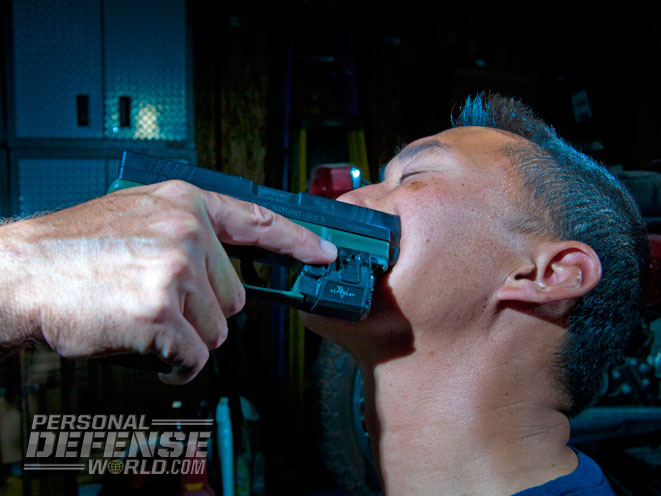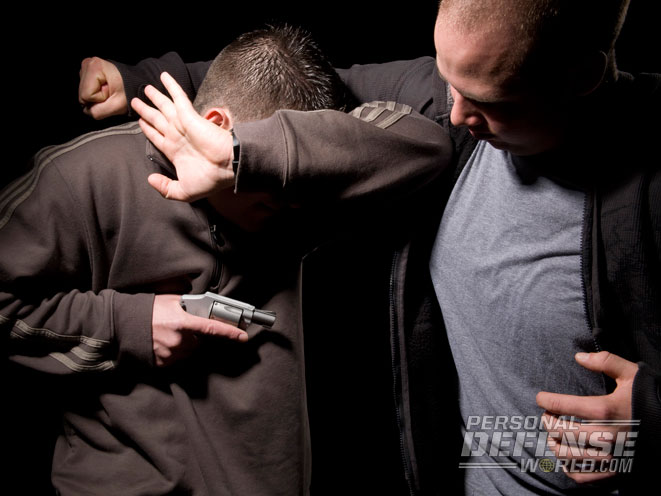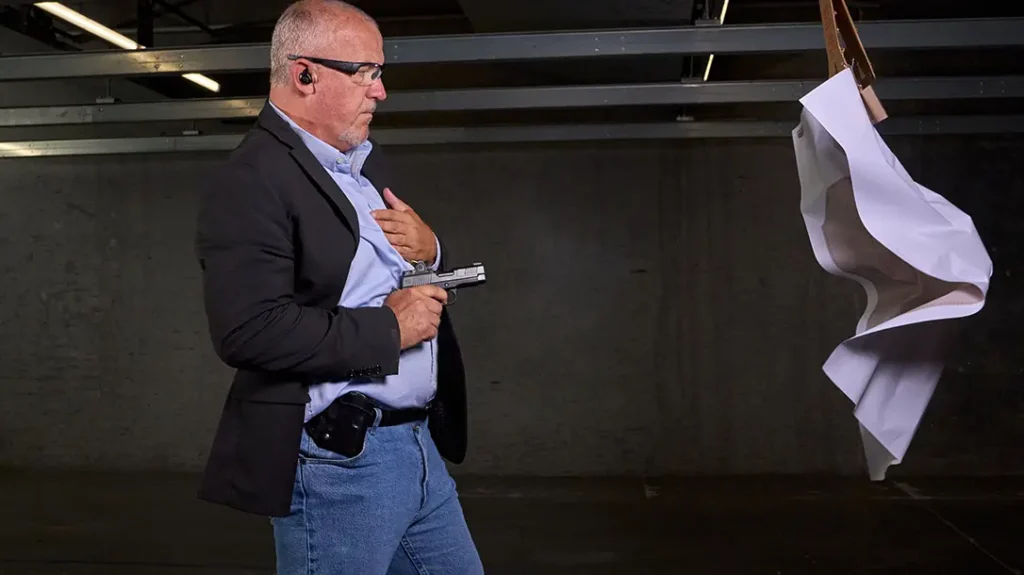Serious students of defensive shooting readily acknowledge that handguns are uncertain stoppers. They therefore train to deliver multiple shots on an attacker and to keep shooting until they decisively stop the threat. Unfortunately, depending upon the nature of that threat, the dynamics of the situation, and the gun you shoot, multiple shots alone may not be enough.
I recently had the opportunity to interview a member of the Los Angeles Police Department‘s (LAPD) Special Investigative Section (SIS) regarding the development of their current issue pistol, the Glock 30S. The criteria for that gun was based on actual SIS gunfight experiences — specifically, the fact that it takes them an average of four rounds of high-performance .45 ACP per target to achieve a decisive stop. And remember, SIS members are exceptional shooters.
What does that mean for the rest of us? It means that smart gunmen should have backup plans. Traditionally, these include “failure-to-stop” drills — shifting fire from center-of-mass shots to the head or pelvis — and, of course, quick reloads to get more rounds into the gun. However, against close-range threats or multiple attackers, you may not have time for these tactics. In those circumstances (and some others) there’s another technique that’s well worth considering: pistol punching.
Advertisement — Continue Reading Below

In simple terms, pistol punching is the act of throwing a punch so as to use the muzzle of the gun as a striking weapon. Although there are other methods of hitting with a handgun, for the sake of simplicity let’s stick with the term pistol punching.
RELATED: Concealed Carry Tactics to Neutralize a Home Invasion
Advertisement — Continue Reading Below
Why would you bother to hit an attacker instead of shooting him? There are actually a number of reasons. As noted above, you may have expended your ammo and still not stopped the threat. If he’s close enough to hit, he’s also close enough to pose a serious threat to you before you can reload. Punching him with a pound of solid steel can potentially solve your problem or at least buy you the time to recharge your gun.
Similarly, if you suffer a malfunction and don’t have time to clear it before your attacker closes the distance between you, striking him with the gun makes perfect sense.
Even if your gun is fully loaded and working properly, in the three-dimensional dynamics of a real defensive situation it’s possible that you may not be able to shoot without endangering innocent parties behind your attacker. If he’s still dangerous to you and shooting safely isn’t possible, pistol punching is a very viable option.
Advertisement — Continue Reading Below
Basic Techniques

Although there are a number of ways to strike with a pistol, a true linear “punch” with the muzzle of the gun offers a number of advantages. Unlike swinging or arcing strikes, it allows you to maintain good muzzle discipline and keeps the gun very decisively pointed at the bad guy. It also focuses the impact on the muzzle for maximum effectiveness and allows sound management of the impact shock through the grip and into the hand. The impact of a linear thrust also tends to drive an assailant back, creating distance and giving you time to change your angle for a better shot and/or get your gun back in the fight.
RELATED: How to Take Down an Active Shooter With a Knife
Advertisement — Continue Reading Below
The best starting position for a pistol punch is a sound weapon-retention position. For a right-handed shooter, your left palm should be solidly anchored to your forehead, just above your left eyebrow, to protect your head and neck. Your gun hand should be indexed along your right pectoral muscle, with the base of your thumb over the nipple and your elbow, hand and muzzle all aligned in a straight line. Very importantly, your trigger finger should be straight and indexed firmly along the side of the gun’s frame.
For safety reasons, it’s best to try this first with a blue gun or other non-firing training pistol and a punching bag or other suitable target. Mark a specific spot on the target at sternum height and stand about one arm’s length from it. Assume a weapon-retention position and naturally align your arm and weapon with the spot by kinesthetically pointing your straight trigger finger at it. Then, slowly drive the gun toward the target with the thought of “poking” the striking point with your finger. This method not only allows you to use the natural coordination of your finger to strike with great accuracy; but it also keeps you from inadvertently squeezing the trigger.

Advertisement — Continue Reading Below
Note that as you strike, your shoulders will naturally rotate to draw your left arm back and away—out of the way of the muzzle. This keeps you from muzzle flashing your non-weapon arm when you hit.
RELATED: 4 Headline-Grabbing Cases That Show the Need for Common Sense Tactics Against Unseen Dangers
Once you’re comfortable with striking at the sternum-level target, move the striking spot up to face level and slowly repeat the process. Again, align your elbow, hand and muzzle and point your index finger naturally at the target. Don’t raise the elbow of your striking hand, but instead allow your index finger to guide the linear path of the gun at a slightly upward angle as you begin to rotate your shoulders to strike. Again, think of poking with your index finger and keep your non-weapon hand anchored to your forehead so it rotates back and out of the way as your gun hand drives toward the target.
Advertisement — Continue Reading Below
After getting a feel for the basic mechanics of the pistol punch, start striking with greater power. Maintain your focus on your straight index finger, but at the same time feel the transfer of the strike’s impact through the gun’s grip and back into your hand—just like the recoil of a shot.
“Battery” Included
Advertisement — Continue Reading Below
At this point you may be wondering if striking with the muzzle of a semi-autopistol will knock the slide out of battery and prevent it from firing. The answer is “yes” followed by a vehement “no.” While the muzzle is in contact with the target, the slide will probably be out of battery and the gun will momentarily be unable to fire. That’s fine, because at that moment you’re hitting your attacker with it. However, as soon as you remove the pressure from the front of the muzzle and slide by retracting the gun, the recoil spring does its job and the gun returns to battery—just like it does every time you squeeze the trigger.
Handgun striking is a very viable close-quarters tactic that separates gunfighters from shooters. If you’re serious about your defensive skills, you should make it part of your close-range arsenal.


































